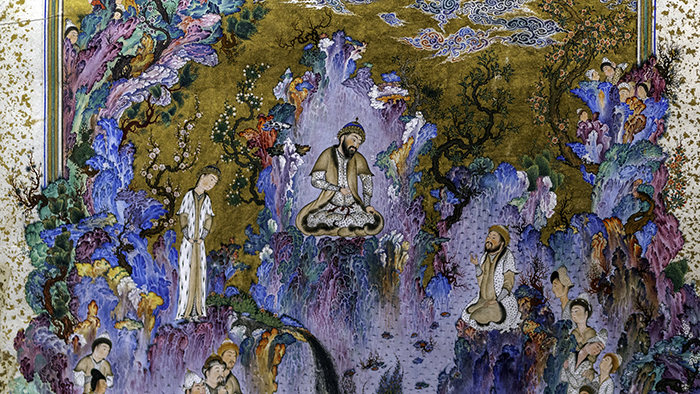Safavid

Brilliantly painted manuscripts. Exquisitely detailed miniatures. Fine silks. Complex, ornate palaces. The art of the Safavids is simply magnificent.
The Safavids were a dynastic family that ruled over modern-day Iran. They sustained one of the longest running empires of Iranian history, lasting from 1501 to 1736. At the height of their reign, the Safavids controlled not only Iran, but also the countries we now know as Azerbaijan, Bahrain, Armenia, eastern Georgia, parts of the North Caucasus, Iraq, Kuwait, and Afghanistan, as well as parts of Turkey, Syria, Pakistan, Turkmenistan and Uzbekistan.
Soon after the Safavids rose to power, they established Twelver Shiism (the largest branch of Shi’a Islam), as the official religion of their dynasty. This distinguished the Safavids from their neighboring and rival empires—the Ottomans (to their west in Turkey), and the Mughals (to their east in India). The Ottomans and Mughals adhered to Sunni Islam. While Shi’a and Sunni share many core Islamic beliefs, the main difference has to do with who succeeded the Prophet Muhammad upon his death in 632. The Sunnis believed the leader should be elected amongst the people, while the Shi’a believed the leader should follow the lineage of Prophet Muhammad’s family.
Safavid art and architecture reflected this adoption of a Shi’a identity. They invested a great deal of their capital into the building and decoration of shrines of Shi’a saints. This encouraged pilgrimages across the great stretch of the Safavid empire, in places such as Karbala and Najaf, two cities in central Iraq. Shi’a Islam is still the official state religion of the Islamic Republic of Iran. The Safavids are therefore widely known for bringing this historic change to the region. However, the original ancestral line of the Safavids was a religious order of Sufi mystics that lived in Ardabil, a city now in Azerbaijan (Sufism is the mystical branch of Islam that originated during the Umayyad caliphate).
The Safavid Empire was one of the most significant ruling dynasties of Iran (16th,17th century). The arts in this period show a far more unitary development than in any other period of Iranian art. One of the unique artistic accomplishment in that era since Islam is tile working; however, History of tile (glazed brick) manufacture in Iran, goes back to prehistoric period.
Safavid art is well known for a new style of decoration, incorporating textile of flowers included the introduction of pale red, yellow colors alternating with blue patterns into ceramic dishes and table wares. There’s also a great range of tile pieces where luster is applied over-glazed on a white or blue glazed ground. Most of the decoration motifs on the tiles relates to natural flora and plants. Tile working has an important position among the various artistic features in Iranian architecture.
in the Safavid period, the motifs and symetric and geometric patters are applied either on wood door frames, colored glass; or as mosaic panel on dome tileworks, wall or ceiling decorative paintings.
For more, visit khanacademy.org


Leave a Reply
Want to join the discussion?Feel free to contribute!